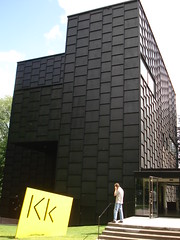Pharmaceutical drugs — especially late 20th century drugs — is a pretty challenging topic for medical museums because of the limited variety of material artefacts available for display.
Vials, capsules, tablets, bottles, cartons and prescriptions look much the same; nor are they among the most evocative kinds of artefacts. Curators have to work hard to compensate for the lack of ‘innate’ presence effects in most objects related to pharmaceutical drugs.
It’s not impossible, of course. Images can do the trick, and so can the pills themselves, if arranged in an innovative way. The ‘Cradle to Grave’ installation in British Museum’s Wellcome Gallery was a revelation when it was first shown in 2003 because it blew new life into these otherwise so non-evocative objects by relating them to the audience’s existential imagination.
In other words, much can be achieved by mobilizing imaginative concepts and ideas. The workshop on ‘Drugs, Standards, and Chronic Illness’ to be held in Manchester, 27-28 November 2009, could be a source of inspiration for how to conceptualize an exhibition on drugs. Says the CFP:
Non-communicable illnesses such as … cancer and cardiovascular disease and the role that the development and marketing of treatments for chronic illness have played in the broader history of standardization in medicine will be the central theme of this workshop. The histories of cancer, cardiovascular disease and other non-communicable illnesses have much in common, but there are important differences between them that are worth exploring. Many of the blockbuster drugs of the last 50 years have been developed for the treatment of cardiovascular disorders. In the course of this development, some illnesses have been transformed from acute to chronic (e.g. malignant hypertension) and it has become acceptable to treat physiological parameters that do not cause symptoms but are statistically associated with illness later in life (e.g. mild hypertension or hypercholesterolaemia). In contrast, and with few exceptions, cancer drugs have often been used to treat what might otherwise be considered as orphan diseases and have rarely been as commercially profitable as cardiovascular drugs. Nevertheless, cancer has been central to the development of many of the practices, such as testing, clinical research, and standardization, which are increasingly applied to other fields of medicine, above all the multi-centre randomised clinical trial.
The meeting will be organized around four main analytical points:
- the management of risk and efficacy
- the structure of biomedical research: laboratories, clinics, protocols
- market conceptualisation, market realities, sales and uses
- regulatory frameworks and regulatory practices
Possible themes include: comparisons, e.g. between different illnesses or across different national contexts; issues surrounding notions of the chronic and the acute or the relationship between risk and disease; spaces of drug administration, from inpatient to outpatient departments; institutional developments; the meaning of ‘chemotherapy’ in different contexts; regulatory institutions, policies and practices; the consumption of medicines, the role of patients and patient organizations, and questions of gender; the establishment of standards, etc.
Send less than 500 words abstracts to Carsten Timmermann (carsten.timmermann@manchester.ac.uk) and Viviane Quirke (vquirke@brookes.ac.uk) before 3 April 2009, More info here.




